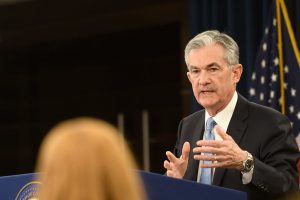The Tale of the Squawking Dove: US Federal Reserve Moves with Cautious Resolve

Jerome Powell
Markets may have disliked what Jay Powell had to say before; however, what he does now proves a bullseye hit – pardon the pun.
The US Federal Reserve surprised no one when, at the end of a two-day policy meeting, its Open Market Committee yesterday unveiled a 0.5 percentage point rise in the federal fund rate. It was the first such robust hike in 22 years and the first back-to-back rate rise since 2006. Usually, the central bank moves in 25 basis point increments.
This time, some traders feared a triple of that as Mr Powell, the US Federal Reserve’s chairperson, had previously promised to act “expeditiously” towards “neutral rates” – i.e., one more aligned with inflation yet unlikely to plunge the economy into a recession.
Such a neutral rate is said to hover around the 2.5%-mark, implying another three 0.5 percentage point jumps, although many economists believe this number is far too optimistic/modest given the exceptionally tight labour market and inflation’s overshoot from the Fed’s own 2% target rate. US core inflation rose to 5.2% in March. Mr Powell admitted that the neutral rate was “not something we can identify with any precision.”
Who Let the Bears Out?
Though the bank does favour (in theory) a more aggressive approach to price stability, analysts detected – and found solace in – dovish undertones. Mr Powell signalled that additional ‘double hikes’ may well be forthcoming. However, he all but discarded ‘triple hikes’, saying that such a 0.75 percentage point rate rise was “not something that the committee is actively considering.”
Mr Powell did remind all and sundry that his bank possesses “both the tools we need and the resolve that it will take to restore price stability.” He also noted that the war in Ukraine and covid-19 lockdowns in China may well increase inflationary pressures stemming from supply chain bottlenecks.
Even before Mr Powell had finished explaining the bank’s rationale, investors began snapping up shares that suffered a battering during weeks of uncertainty and bears on a rampage.
That sentiment worked its way through the time zones in a wave of cautious optimism. In Asia, of late home to rather depressing markets, the Tokyo Stock Exchange remained closed for a public holiday, but the Shanghai Composite gained a modest 1.1% whilst Hong Kong’s Hang Seng added 0.7%.
Taking the Hint
There was considerably more excitement in the western world. US markets closed on a high with Nasdaq gaining 3.2% on Wednesday, propelled by Airbnb (ABNB) recovering some of the ground (+7%) that it had lost in April – rather mysteriously given the travel company’s excellent performance – when the stock retreated 11% in what pundits deemed an “overblown market correction.” The S&P 500 advanced 3% and the Dow Jones 2.8% on Mr Powell’s words.
Europe eagerly took the hint, thankful to ignore – if only for a few moments – the shooting war along its eastern edge and the looming energy squeeze. In early morning trading the bellwether STOXX 600 index tentatively ballooned 2% only to deflate a bit as markets found their footing. The FTSE 100 likewise tapered as the day wore on, still adding almost 1%. Amsterdam and Paris were much more festive with the AEX advancing 1.8% and the CAC 40 trailing just behind with 1.6%. Madrid was also fairly buoyant.
Softish Does It
Mr Powell said there was a “good chance” of a “softish landing” for the US economy, pointing to solid corporate and household earnings as signs that a recession may yet be avoided. This prompted a strategist at JPMorgan to quip that after years cooing, the dove now tries to squawk like a hawk in a spectacle that some analysts considered rather unconvincing or even unedifying.
During the presentation of its policies, the Fed also unveiled plans for shrinking the size of its $9tn balance sheet. The bank announced that it will no longer reinvest the proceeds of maturing securities. At first, the run-off is to be capped at $30bn/month for Treasury paper and $17.5bn for mortgage-backed securities. This threshold will gradually be raised to $60bn and $35bn respectively.
Whilst the effort is appreciated, it also falls short of market expectations. The goldilocks scenario painted by Mr Powell – an economy robust enough to absorb monetary tightening in stride – somehow fails to convince. So does the explanation that the price index is moving up at a worrisome clip due to supply chain malfunctions.
Whilst geopolitical upheavals and China’s increasingly desperate-looking lockdowns are not at all helpful, inflation is still defined as too much money chasing too few goods. The too-much-money-side of the equation sprang, of course, from years of quantitative easing in its various guises. It is also good to remind that core inflation is purged of both the food and energy sectors – precisely those most affected by the fighting in Ukraine.
Moreover, the present federal funds rate of 0.75-1% is so far out of whack with inflation that it will surely require a significantly higher-than-neutral rate to tame the beast and usher or whip it back into its cage. Even with mended, rerouted, or widened supply chains, the monetary expansive ingredient of inflation still hovers around 3.5% or so annually, requiring a 4.5-5% benchmark interest rate – at the very least – to push it down. Then again, maybe conventional wisdom is just no longer in vogue.
You may have an interest in also reading…
Is it Time to Put AI in Charge of Pricing Strategies? Most Firms Seem Hesitant to Take the Leap
Despite corporates enthusiasm for AI, its use in pricing strategies — using algorithms to determine optimal prices for goods and
Former Student Protest Leader Claims Presidency in Chile
A land of geographical and political extremes, Chile seems to have rejected moderation and elevated a former student protest leader
UN Chief: Countries Bound for COP27 Must Make Climate Action ‘The Top Global Priority’
As government representatives begin the finalize the agenda for the COP27 climate change conference in Egypt next month, for pre-COP planning in


















































































